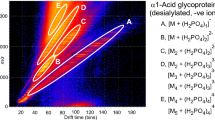Abstract
N-linked glycans were released from chicken ovalbumin by hydrazinolysis and examined by matrix-assisted laser desorption/ionization mass spectrometry. Postsource decay analysis showed that most fragment ions arose as the result of internal glycosidic cleavages involving loss of nonreducing terminal residues from ions that had lost one or both GlcNAc residues from the chitobiose core [GlcNAcβ(1→ 4)GlcNAc]. Cross-ring fragments were abundant from the reducing-terminal GlcNAc but other cross-ring fragments were weak. The ion found to be most useful for determining the composition of the antennae attached to the 3- or 6-linked core mannose residues was an internal cleavage ion formed by loss of both the chitobiose core and the antenna linked to the 3-position of the core branching mannose. This ion was observed to lose water in the absence of a “bisecting” GlcNAc residue (β1 → 4 linked to the core mannose) and to lose a GlcNAc molecule (221 mass units) when a bisecting GlcNAc residue was present.
Similar content being viewed by others
References
Stahl, B.; Steup, M.; Karas, M.; Hillenkamp, F. Analysis of neutral oligosaccharides by matrix-assisted laser desorption/ionization mass spectrometry. Anal. Chem. 1991, 63, 1463–1466.
Harvey, D. J.; Rudd, P. M.; Bateman, R. H.; Bordoli, R. S.; Howes, K.; Hoyes, J. B.; Vickers, R. G. Examination of complex oligosaccharides by matrix-assisted laser desorption/ionization mass spectrometry on time-of-flight and magnetic sector instruments. Org. Mass Spectrom. 1994, 29, 753–765.
Spengler, B.; Kirsch, D.; Kaufmann, R.; Lemoine, J. Structure analysis of branched oligosaccharides using post-source decay in matrix-assisted laser desorption/ionization mass spectrometry. J. Mass Spectrom. 1995, 30, 782–787.
Harvey, D. J.; Naven, T. J. P.; Küster, B.; Bateman, R. H.; Green, M. R.; Critchley, G. Comparison of fragmentation modes for the structural determination of complex oligosaccharides ionized by matrix-assisted laser desorption/ionization mass spectrometry. Rapid Commun. Mass Spectrom. 1995, 9, 1556–1561.
Patel, T.; Bruce, J.; Merry, A.; Bigge, C.; Wormald, M.; Jaques, A.; Parekh, R. Use of hydrazine to release in intact and unreduced form both N- and O-linked oligosaccharides from glycoproteins. Biochemistry 1993, 32, 679–693.
Harvey, D. J. Quantitative aspects of the matrix-assisted laser desorption mass spectrometry of complex oligosaccharides. Rapid Commun. Mass Spectrom. 1993, 7, 614–619.
Harvey, D. J.; Wing, D. R.; Küster, B.; Wilson, I. B. H. Composition of N-linked carbohydrates from ovalbumin and co-purified glycoproteins. J. Am. Soc. Mass Spectrom. 2000, 11, 564–571.
Yamashita, K.; Tachibana, Y.; Kobata, A. The structures of the galactose-containing sugar chains of ovalbumin. J. Biol. Chem. 1978, 253, 3862–3869.
Da Silva, M. L. C.; Stubbs, H. J.; Tamura, T.; Rice, K. G. 1H NMR characterization of a hen ovalbumin tyrosinamide N-linked oligosaccharide library. Arch. Biochem. Biophys. 1995, 318, 465–475.
Piskarev, V. E.; Sepetov, N. F.; Likhosherstov, L. M.; Galenko, E. L.; Derevitskaia, V. A. Structure of carbohydrate chains of the riboflavin-binding glycoprotein of chicken egg protein. II. 1H-NMR (500 MHz) spectroscopy of the major neutral oligosaccharides. Bioorg. Khim. 1989, 15, 156–1554.
Yamashita, K.; Kamerling, J. P.; Kobata, A. Structural studies of the sugar chains of hen ovomucoid: Evidence indicating that they are formed mainly by the alternate biosynthetic pathway of asparagine-linked sugar chains. J. Biol. Chem. 1983, 258, 3099–3106.
Yamashita, K.; Kamerling, J. P.; Kobata, A. Structural study of the carbohydrate moiety of hen ovomucoid: Occurrence of a series of pentaantennary complex-type asparagine-linked sugar chains. J. Biol. Chem. 1982, 257, 12809–12814.
Paz-Parente, J.; Strecker, G.; Leroy, Y.; Montreuil, J.; Fournet, B.; van-Halbeek, H.; Dorland, L.; Vliegenthart, J. F. Primary structure of a novel N-glycosidic carbohydrate unit, derived from hen ovomucoid. A 500-MHz 1H-NMR study. FEBS Lett. 1983, 152, 145–152.
Egge, H.; Peter-Katalinic, J.; Paz-Parente, J.; Strecker, G.; Montreuil, J.; Fournet, B. Carbohydrate structures of hen ovomucoid. A mass spectrometric analysis. FEBS Lett. 1983, 156, 357–362.
Domon, B.; Costello, C. E. A systematic nomenclature for carbohydrate fragmentations in FABMS/MS spectra of glycoconjugates. Glycoconjugate J. 1988, 5, 397–409.
Zal, F.; Küster, B.; Green, B. N.; Harvey, D. J.; Lallier, F. H. Partially glucose-capped oligosaccharides are found on the haemoglobins of the deep-sea tube worm Riftia pachyptila. Glycobiology 1998, 8, 663–673.
Kovácik, V.; Hirsch, J.; Kovác, P.; Heerma, W.; Thomas-Oates, J.; Haverkamp, J. Oligosaccharide characterization using collision-induced dissociation fast atom bombardment mass spectrometry: Evidence for internal monosaccharide residue loss. J. Mass Spectrom. 1995, 30, 949–958.
Brüll, L. P.; Heerma, W.; Thomas-Oates, J.; Haverkamp, J.; Kovácik, V.; Kovác, P. Loss of internal 1→ 6 substituted monosaccharide residues from underivatized and per-O-methylated trisaccharides. J. Am. Soc. Mass Spectrom. 1997, 8, 43–49.
Brüll, L. P.; Kovácik, V.; Thomas-Oates, J. E.; Heerma, W.; Haverkamp, J. Sodium-cationized oligosaccharides do not appear to undergo ‘internal residue loss’ rearrangement processes on tandem mass spectrometry. Rapid Commun. Mass Spectrom. 1998, 12, 1520–1532.
Harvey, D. J.; Bateman, R. H.; Green, M. R. High-energy collision-induced fragmentation of complex oligosaccharides ionized by matrix-assisted laser desorption/ionization mass spectrometry. J. Mass Spectrom. 1997, 32, 167–187.
Rouse, J. C.; Strang, A.-M.; Yu, W.; Vath, J. E. Isomeric differentiation of asparagine-linked oligosaccharides by matrix-assisted laser desorption-ionization postsource decay time-of-flight mass spectrometry. Anal. Biochem. 1998, 256, 33–46.
Author information
Authors and Affiliations
Corresponding author
Rights and permissions
About this article
Cite this article
Harvey, D.J. Postsource decay fragmentation of N-linked carbohydrates from ovalbumin and related glycoproteins. J Am Soc Mass Spectrom 11, 572–577 (2000). https://doi.org/10.1016/S1044-0305(00)00121-5
Received:
Revised:
Accepted:
Issue Date:
DOI: https://doi.org/10.1016/S1044-0305(00)00121-5




